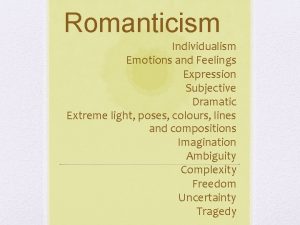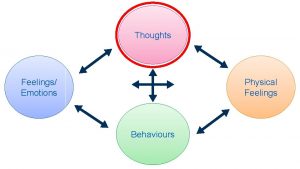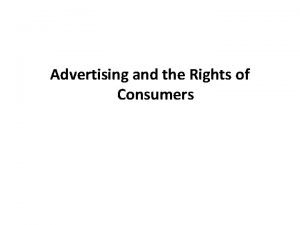Associated Feelings The use of feelings in advertising















- Slides: 15

Associated Feelings

The use of feelings in advertising is resorted to when audience response feelings is of primary importance and usually little or no information content is involved.

When are feelings ads used? Ads evoking feelings are most likely to be used when consumers have a low level of intrinsic interest in the product category or brand. They do not have or care to have strong brand attitudes

Feelings ads typically have a • Evaluative component – influenced by beliefs about the brand • ‘Liking’ component – that cannot be explained by knowledge and beliefs The relative importance or % contribution of ‘liking’ will be high when the amount of brand attribute information and association processing efforts are low - Michael Ray and Rajeev Batra

FCB Grid Think H. I. L. I. Feel House, child’s education, car Luxury items, Designer wear, Jewellery Groceries, detergents, fuel Food items, Cosmetics, chocolates

Rossiter-Percy Grid Informational -ve motivations H. I. Search and Conviction necessary L. I. Trial experience sufficient Transformational +ve motivations

The Association Process A consumer who feels certain feelings when a brand name is mentioned can remember those feelings much later when the brand is being thought of. Ad-evoked feelings and brand names can and do become linked and associated in consumer’s mind. – Douglas Stayman and Rajeev Batra

Transformational Advertising • It involves developing associations with the brand such that it transforms the use experience • Two types of associations – the use experience and the user

• It must make the experience of using the product richer, warmer, more exciting and /or more enjoyable than that obtained solely from an objective description of the brand. • It must connect the experience of the brand so tightly with the experience of using the brand that consumers cannot remember the brand without recalling the experience generated by the advertisement.

For transformational advertising to work, it must have • A substantial media budget • Maintain consistency over time • Closely connect the brand with the advertising

Drama Advertising • This advertising dramatises the situation. Feelings are naturally evoked based on the plot and situation.

Humour ads • These cannot be used for all situations. • If not handled properly, can be very damaging for the product • Matching quality of humour to the target audience • Diminishes CAs because it distracts from cognitive responses

Fear and anxiety ads • These ads directs compliance to remove the fear/threat as depicted by the ad. If the element of fear or anxiety is too much it can be a ‘turn-off’. If the level of is too low it may not motivate the audience to comply with what is being suggested.

Fear appeal ads need 4 conditions to be successful • Depicted threat is very likely • It can have severe consequences • That the advocated behavioural change/action will lead to removal of threat • That the consumer can take such action

What affects intensity of feelings? • Believability • Empathy
 Feelings feelings feelings
Feelings feelings feelings Global advertising and international advertising
Global advertising and international advertising Công của trọng lực
Công của trọng lực Thế nào là số nguyên tố
Thế nào là số nguyên tố Tỉ lệ cơ thể trẻ em
Tỉ lệ cơ thể trẻ em đặc điểm cơ thể của người tối cổ
đặc điểm cơ thể của người tối cổ Các châu lục và đại dương trên thế giới
Các châu lục và đại dương trên thế giới ưu thế lai là gì
ưu thế lai là gì Thẻ vin
Thẻ vin Các môn thể thao bắt đầu bằng từ đua
Các môn thể thao bắt đầu bằng từ đua Tư thế ngồi viết
Tư thế ngồi viết Bàn tay mà dây bẩn
Bàn tay mà dây bẩn Hát kết hợp bộ gõ cơ thể
Hát kết hợp bộ gõ cơ thể Từ ngữ thể hiện lòng nhân hậu
Từ ngữ thể hiện lòng nhân hậu Trời xanh đây là của chúng ta thể thơ
Trời xanh đây là của chúng ta thể thơ Tư thế ngồi viết
Tư thế ngồi viết




























